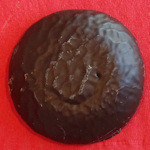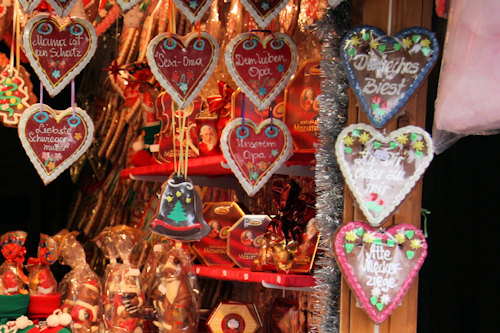
Lebkuchen is another food closely associated with Christmas in Austria. Its main function is to mark the opening of the festive season through a dramatic takeover of the supermarket biscuit section.
- Almost-but-not-quite gingerbread
- Comes in all sorts of shapes and sizes
- Not just for Christmas (but unavoidable at that time)
- Book a concert & dinner* for Vienna
- Look for “+ dinner” among the listings
- See also:
What is Lebkuchen?

(The inner Lebkuchen revealed)
Most dictionaries translate Lebkuchen as “gingerbread”, but that’s not quite right. “Gingerbread-like”, perhaps. Consider it a rich, dry, soft biscuit pastry that traditionally uses plenty of honey and spices.
The “Lebkuchen spice mix” in our kitchen cupboard, for example, consists of cinnamon, nutmeg, coriander, ginger, fennel, cloves, allspice, aniseed, and cardamom.
(And, of course, a generous pinch of love as the special ingredient.)
Although available all year, Lebkuchen has a strong association with Christmas.
Nothing announces the arrival of Advent quite like great aisles of the stuff suddenly appearing in grocery stores, usually while the Halloween chocolate is still being put away.
Lebkuchen also occupies a place of honour on the plate of Christmas biscuits you bring out when guests come round in December.
The origins of this seasonal association remain unclear, but a strong theory is the pastry’s suitability for the traditional Advent fasting period of times gone by.

(The Pirker Lebkuchen store on Vienna’s Stephansplatz square)
For a quick (and cheap) idea of the taste, pop into any supermarket for the mass-produced biscuit-shaped variety. Alternatively, look out for the handmade and specialty Lebkuchen in family bakeries or on market stands.
The biscuits come in all sorts of shapes and sizes, but the commonest is the raised, round form (as in the photo earlier). Common varieties are plain, garnished with nuts or dried fruits, or smothered in a chocolate couverture.
As you might imagine, central Europe has a long, long, long tradition of Lebkuchen baking with various regional varieties.
We order boxes from a bakery in the Styrian mountains, for example, where production dates back to 1587.
When browsing through 18th-century newspapers for research, I often discover adverts for Lebkuchen, particularly the Nuremberg variety (that German city remains possibly the most famous source of this culinary delight).
Lebkuchen hearts

(A common sight at seasonal markets)
If you’re visiting one of Vienna’s Christmas markets, look out for the large Lebkuchen hearts, often decorated with icing and bearing messages like “World’s Best Granny”.
The pastry is harder, so these hearts have a better-than-average chance of surviving the lottery of baggage handling if you want to take some home with you as a gift.
The Austrian equivalent of the gingerbread house also uses this robust Lebkuchen variety. With luck, you might see a house on display at a market: one of the stands at the Christkindlmarkt, for example, often has one.
Finally, a little bonus tip for shoppers…
One of the more famous Lebkuchen producers began life in 1846 in the town of Mariazell in the Styrian alps (about a 2 hour drive southwest of Vienna).
The Pirker family business now has a flagship store in the very centre of Vienna. Find it at Stephansplatz 7, next to the big cathedral.